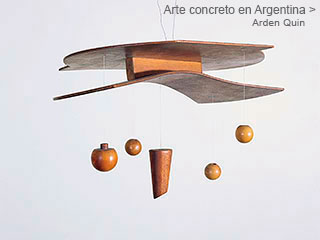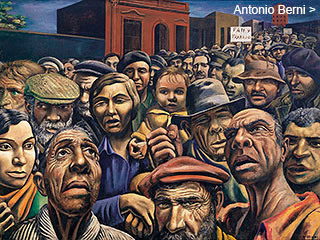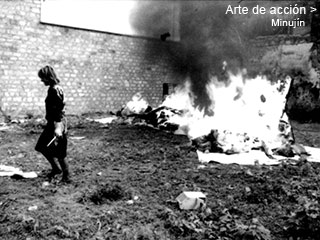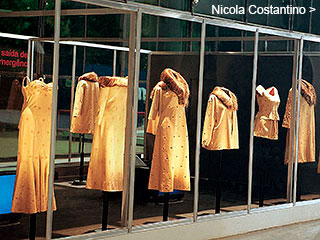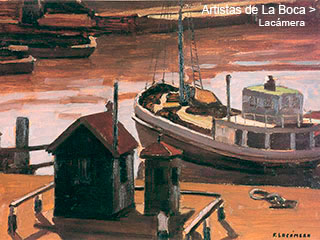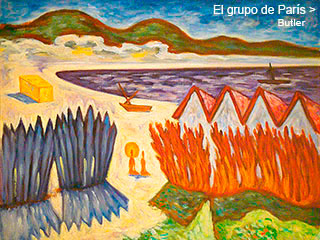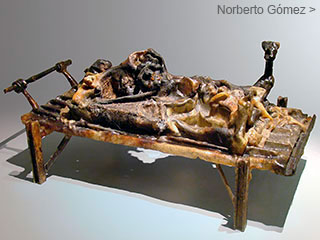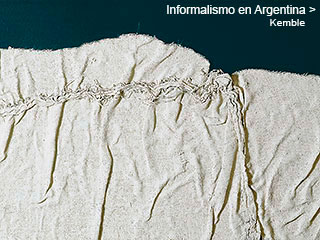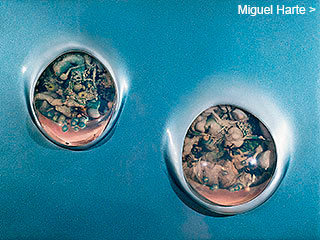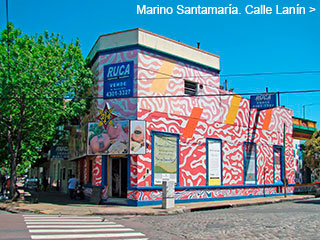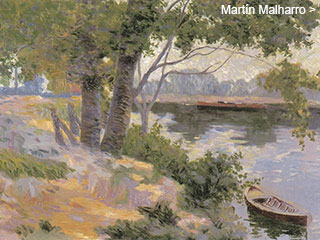Menú
Algunos dossiers
Concrete Art
in Argentina
in Argentina
by
Adriana Lauria
January 2003
January 2003
Abstraction asserted itself in Argentina through the achievements of groups such as Arte Concreto-Invención, Madí and Perceptismo, which developed their activity since the second half of the 1940s. These groups constituted the first organized national avant-garde and made their aesthetics known to the public through exhibitions, magazines, manifestoes, leaflets, lectures, etc.
Documents
Raúl Lozza
Raúl Lozza. “Ante la decadencia y el espíritu...” (In View of Decline and Spirit...), in: Raúl Lozza. Primera exposición de pintura Perceptista (First Exhibition of Perceptista Painting. Exhibition’s catalogue). Buenos Aires, Galería Van Riel, 1949.
In view of the decline and the negative character already engaging the whole world of representation and interpretation in figurative art, Perceptismo imposes in the observer a dynamic attitude with regard to action and the stimulation of his own active competence, creating new conditions for vision and aesthetical emotion, surpassing the old temporal process imposed to visual perception in the act of the aesthetical contemplation, process that involves the subjugation of both, man’s creative faculty as well as that of planes and relations within the art reality itself.
In my book about color I have already said that, for an art of space, the sense of visual perception has to be objectively exalted through the structure of perceptive matter. This consists of achieving, by means of the knowledge we are endowed with through the whole of our feelings as well as through our mental power, a visual objectivity. In figurative painting, the visible means that condition the structure of the work are not supported by the properties inherent to color and shape; instead, the represented object, its tri-dimensionality, known to us through our general experience, acts in the way of weight and balance.
Because of this, at the same time it withdrew from representing known objects in the surrounding world, art faced a new problem on bringing near those material elements in painting by way of the intuition of their values.
Perceptismo goes beyond this intuitive stage still existing in abstract and concrete painting, and it eliminates the dualism between color and shape. Revolutionizing the old norms, it creates a new realistic concept of functional structure; on leaving behind the old contradiction between form and contents, it opts for the dialectical method that admits the very process of material elements.
Idealists have made every effort to unify form and contents in figurative art, not excelling representative forms, symbols or plastic anecdotes expressed onto a plastic background. Yet they have not succeeded to conciliate the irreconcilable. According to my ideas and my practice of art, form and contents constitute a unique, indivisible real fact, given by the visible artistic matter in its creation and invention process itself.
An art of imitation, not of transformation, no longer deserves to be called art.
Perceptismo is not complemented by the environment, but it drives the environment’s development. It is not an outcome of the environment, but it is determined through the environment’s renewing power. With the new concept of structure and the measuring of the perception of plastic values in relations, I have not discovered the philosopher’s stone in art, but that it all means the practical actuality of an objective and materialist philosophy of aesthetics. Technique, consubstantial to the creation process of the aesthetical object, no longer constitutes a rigid, abstract and purist standard, separate from a purported contents, to involve a full attitude, a full process of creative consciousness.
Consequently, it is not the shelter of painting in a geometric and mathematic idealism, but the integrity [sic] to its historical reality and to the unequivocal, unmistakable nature of its social role as a revolutionary fact and as a dialectic process of creation material elements.
Perceptismo is not an improvisation art, an imagination art, but an art of knowledge, for image is also an object, the plastic objectification of which would mean a representation. Outdoing any prehistoric remains, the new painting stands against both academicism and the new academic neo-realists.
Against the platonic purism that stresses the shallowness and improvisation in a metaphysical painting wrongly based upon geometric and mathematic elements. Against the snobs who gather like parasites around a paranoiac, intimate and salon art which sustains them.
Against any remains of individualist interpretation, the visible mediocrity and decline outcome of which marks the end of the representative era.
Painting, as every art, must observe a structure. However, this one can no longer be limited to the superficial array of images or signs; it must constitute, instead, the product itself of a process, that one of the very visible matter, known in practice as reality.
Sheer attitude by itself, in art, is a paradox. It is foreign to any transformation, to any revolution in the practical field of creation and of artistic invention, for it lacks an objective structure. In spiritual activity, sheer attitude constitutes a sophism; it makes evident the impotence of the intellectual who eludes a concrete stance in a socially revolutionary environment.
Thus, Perceptismo reveals itself as the superior and most advanced stage in painting. It opens a new age in art, and it defers from the rest of Abstract and Concrete schools in the essential fact that it has achieved for the first time ever the reality of the color-plane, a new concept of structure intimately related to the practical processing of the creation’s visible means, and the prevailing over the contradictions between form and contents, raison d’être of the representative art and nightmare of the abstract art.


